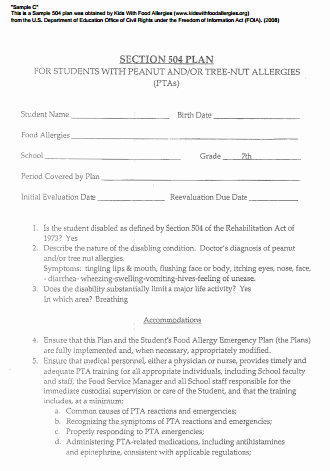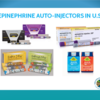School Health Care Plans for Your Child with Food Allergies
How to Create a Comprehensive School Health Care Plan for your Child with Food Allergies
by Lynda Mitchell, MA
A school health plan will identify the types of responsibilities, training and services required to keep your child's environment safe and how to respond to an emergency, should one arise.
As a parent sending your child off to school for the first time, it is normal to experience a myriad of emotions. Although this can be a time of great anticipation and excitement, all parents have the usual concerns: Will my child like his new school? Will he like his teacher? Will he get on the right school bus? Will the program be one that allows him to grow and learn in a positive environment?
As a parent of a child with food allergies, you have yet another dimension added to the anticipation and worries of sending a child off to school. In addition to all of the usual concerns, you will worry about his health needs and safety. What will he eat? How will he be able to participate safely in classroom and cafeteria activities? Will my child get sick at school? Will the school be able to respond promptly to an emergency? Does the school have a full time school nurse? Will the school arrange for my child to be given medicines or special asthma treatments during the school day?
Concerns such as these are legitimate and understandable. You will have to "let go" of your child for the first time, and entrust your child's health to staff with whom you are unfamiliar. You will have to trust that the school staff will learn to manage your child's allergies safely, and learn how to respond to any emergency.
How will you ensure that they do it? The key is to work with the school cooperatively and proactively to create a comprehensive school health care plan. A school health care plan will identify the types of responsibilities, training and services required to keep your child's environment safe and how to respond to an emergency, should one arise. The three most common plans used for food allergic children are known as Emergency Care Plans (ECP), Individualized Healthcare Plans (IHCP) and 504 Plans.
Getting Started
The best way to have the school begin to plan for your child is to notify the school principal in writing about your child's food allergies; and request a meeting to initiate a plan to ensure his safety and manage his health issues while at school. Some schools will require a letter from your child's physician detailing his or her food allergies and the special care and medications that will be required at school. Try to initiate this contact prior to the beginning of the school year so that a plan can be developed in time for the start of school. Use a positive attitude when approaching the school and consider yourself a part of the team that will work together to make sure your child is safe at school. The key is frequent, calm and confident communication.
Emergency Care Plans (ECP)
Doctors write medical orders for school nurses to follow. Emergency Care Plans (ECP) may be used to refer to a doctor’s order or as an additional form to supplement the doctor’s written medical orders. ECPs are written in terms understood by non-medical persons and should include a list the allergens the student needs to avoid; a list of symptoms that require emergency treatment with an epinephrine auto-injector, instructions on calling 911 to transport student to the hospital; and a list of emergency contacts.1 The Food Allergy Emergency Care Plan by FARE is a commonly used form in the school setting for this purpose. The child’s physician or allergist must sign the ECP.
Individualized Health Care Plans (IHCP)
An Individualized Health Care Plan (IHCP) (also sometimes referred to as an IHP) is a type of nursing care plan that fulfills both administrative and clinical purposes. For the food allergic child, an IHCP also contains an emergency care plan (see above) for managing and treating an allergic reaction, should one occur while the child is at school.
IHCPs should be written by the school nurse in collaboration with the student, family, educators, and healthcare care providers.2 Every student with a confirmed diagnosis of food allergy and medical orders should have an IHCP.3
An IHCP addresses what the school will do to establish and maintain a safe school environment for the food allergic child. For example, An IHCP will detail what measures the school team will take to reduce the risk of allergen exposure, recognize symptoms of an allergic reaction and promptly intervene with the appropriate treatment.4 An IHCP is typically not a legally binding document.1
Section 504 Plans
A 504 Plan is a contract between a school and a student.5 Having a 504 plan in place is particularly important when any concerns exist with regard to effective food allergy management, such as lack of a full time nurse, limited school resources, or lack of effective policies and procedures.1
The 504 Plan takes its name from Section 504 of the Rehabilitation Act of 1973, a federal law that prohibits schools that receive federal funding from excluding or otherwise discriminating against a student with a "disability" solely on the basis of that disability.6 A "disability" under Section 504 is defined by the Americans with Disabilities Amendments Act (ADAA) as a "physical or mental impairment which substantially limits one or more major life activities." A "major life activity" includes walking, seeing, hearing, speaking, breathing, learning, working as well as eating.7
Public elementary and secondary recipients are required to provide a free appropriate public education (FAPE) to qualified students with disabilities. Such an education consists of regular or special education and related aids and services designed to meet the individual educational needs of students with disabilities as adequately as the needs of students without disabilities are met. This includes nonacademic and extracurricular services and activities, including meals, recess periods, and the services and activities.8
In the case of severely food allergic students, a FAPE usually includes the provision of "related aids and services" such as administration of medication, changes to the classroom environment, menu substitutions, or other health-related needs that require attention during the school day.6
In order for a student to obtain a 504 plan, the child first needs to be evaluated for eligibility by the school as meeting the definition of “disabled” Parents can request in writing that their child be evaluated for eligibility under the process defined by Section 504. To assist in the evaluation process the school will undertake, parents should be prepared to provide documentation from the child’s doctor to the school to support the assertion that the child’s food allergies cause a substantial limitation of a major life activity.
While the purpose of a 504 plan is essentially the same as that of an IHCP, a 504 Plan is a legally binding document that offers procedural due process safeguards not afforded by traditional IHCPs, including due process hearings (with representation legal counsel, if so desired) and parental notice and review requirements. Ultimately, if a parent continues to be dissatisfied with the plan as implemented by the school district, s/he can seek redress with the Office of Civil Rights (U.S. Department of Education), and beyond that, with the federal courts.
All public schools are covered by Section 504. Private schools, including preschools, are also covered if their schools receives or has received some form of federal funding. Many, though not all, private schools do indeed receive federal monies.
Issues to Address in the IHCP or 504 Plan
You as the parent can work in partnership with school personnel and your child’s physician as appropriate to develop the contents of your child's IHCP or 504 plan based upon his or her unique allergy health and safety needs while at school. Avoidance measures and reducing exposure to allergens employed should be evidence-based and use best-practice standards.1
 • Signs and symptoms of an allergic reaction
• Signs and symptoms of an allergic reaction• List of all allergies and the severity of each (food and environmental)
• Emergency treatment plan, including list of child's medications
• Training of staff - how it will be done and who will do it
• Use and training of substitute teachers
• Use and training of delegates, if a full time school nurse is not on premises
• Parent responsibilities, child responsibilities, nurse responsibilities, other school staff responsibilities
• Rules child will follow while at school (e.g., food sharing rules, whether he can accept party treats or food rewards, whether he can eat a school lunch)
• Changes in the classroom, cafeteria and elsewhere (e.g., "peanut free tables", changes in hand soap to nut-free soaps, no latex balloons, etc.)
• Use of food in art projects and other lesson plans
• Storage of safe snacks and a safe non-perishable lunch in the event the need for these items arises (e.g., forgotten lunches, evacuations, shelter-in-place situations)
• Other issues pertinent to your child and his specific food allergies, such as procedures to be followed on field trips, on the school bus, for school parties, and for other potential risk situations, etc.
Choosing a Plan
Determining which plan is right for your child depends on parent preference and also what federal or state disability laws, if any, are applicable to the school he or she attends, as to whether the severity of the child's food allergies qualifies as a "disability." . A student does not need to have a disability (as defined by the Americans with Disabilities Amendments Act) (ADAAA) to receive an IHCP. However, a student must have an evaluation by the school that determines the child meets the ADAA definition of disability to be eligible for a 504 Plan.
The format an IHCP or 504 Plan takes varies widely. In some schools, there might be a form or multiple forms, or a specified format. In others, there may be no pre-established forms or formats. You will have to ask your school to find out how IHCPs or 504 Plans are documented in order to work with the school to develop one for your child.
No matter which plan you use for your child, make sure it is in writing. A written plan is essential for the school staff, as well as you and your child, to understand the roles each will play in ensuring your child's safety and care while at school. Make sure the plan addresses key issues that require attention in the classroom and elsewhere in the school. The plan must also include medication orders and an emergency treatment plan defined by your child's physician.
Other Laws that May Protect a Severely Food-Allergic Student
Individuals with Disabilities in Education Act (IDEA)
The IDEA was designed to ensure that children with disabilities are provided with services and accommodations necessary to allow them to attend a public school program. The IDEA defines a child with disability as one who, by reason of his disability, "needs special education and related services."9
A child with severe food allergies typically does not qualify for coverage under the IDEA unless the child needs special education in addition to accommodations and health services for his food allergies. Therefore, most children with severe food allergies will not qualify for an Interdisciplinary Education Plan (IEP), a type of educational program that is designed to meet a disabled child's unique needs, under the provisions of the IDEA, even though these children may indeed qualify for a 504 Plan. Schools often confuse the standards under IDEA with those of Section 504. To qualify for a 504 Plan, a student must have a disability that limits a major life activity and has nothing to do with a child’s ability to learn. Schools mistakenly deny food allergic students a 504 Plan because they conclude that the allergy does not affect the student’s ability to learn. Thus, it is important to understand the difference between IDEA and Section 504 so you can effectively advocate for your child’s needs in the school setting.
Americans with Disabilities Act Amendments Act of 2008
The Americans with Disabilities Act (ADA), is another federal law that often offers protections to students with life-threatening food allergies. The ADA was amended in 2008 as the Americans with Disabilities Amendments Act (ADAAA).
One of the most important differences between the ADAAA and Section 504 is that the ADAAA applies to most schools regardless of whether they receive federal funding. Specifically, Title II of the ADAAA applies to public schools and Title III to "places of public accommodation," which includes non-religious private schools and private daycare centers.
Title II. The Americans with Disabilities Act was amended in 2008 (Americans with Disabilities Amendments Act) to broaden the definition of disability10 to make more students potentially eligible for 504 plans than had been the case in the past. Title II requires public schools and private schools receiving federal money to all of the rights and remedies under Section 504 of the Rehabilitation Act7 including that of a free and appropriate education (FAPE) in the least restricting environment (LRE).11
Title III. Title III of the ADAAA requires that private, non-religious schools take necessary steps to make sure that no child, due to his disability, is "excluded, denied services, segregated or otherwise treated differently than other individuals because of the absence of auxiliary aids and services, unless the entity can demonstrate that taking such steps would fundamentally alter the nature of the good, service, facility, privilege, advantage, or accommodation being offered or would result in an undue burden." 12 Unlike a public school that is required to provide a FAPE in the least restrictive environment, a private school can refuse an accommodation if that accommodation fundamentally alters the program or service, or if the school believes it will result in an “undue burden.” Regardless, private, non-religious schools cannot refuse to an administer epinephrine auto-injector to those children who experience life-threatening allergic reactions to certain foods, such as peanuts, or bee stings.13
State Disability Laws
Some states have passed their own disability laws that may provide for additional rights and protections beyond those spelled out by the federal laws. For more information, contact your state's Department of Education.
What to Do if the School Will Not Work with You
As noted above, public schools must comply with the requirements of both Section 504 and the ADAAA. Many private schools are also covered by Section 504 by virtue of the fact that they receive federal funds. Moreover, all non-religious private schools must abide by the ADAAA.
Thus, most schools - whether public or private - cannot refuse to accept a child whose food allergies qualify as a "disability" solely because of the child's food allergies. Schools have an obligation to provide necessary services to ensure that a food allergic child is safe, and cannot refuse to administer an epinephrine auto-injector such as Epi-Pen®, Auvi-Q® Adrenaclick®, or generic auto-injectors.13,14
Should your school's principal not be willing to make the accommodations necessary for your child, you can contact your school district's Superintendent or school district's 504 Coordinator, in writing, to try to resolve the situation. Should that not be successful, you can then contact your state's Department of Education, which is responsible for enforcing compliance with Sections 504 and the IDEA. Violations of Section III (non-religious private schools and private daycare centers) of the ADAAA are handled by the Department of Justice (DOJ) Disability Rights Section. Violations of Section II (public schools and private schools receiving federal funds) of the ADA are overseen by the Department of Education's Office for Civil Rights (OCR).
Stay Positive!
Remember to stay positive and focus on what your child needs to stay safe while at school. You may have to educate the school about its duty to make necessary changes to provide the accommodations and health services your child needs.
Keep in mind that school planning is a process. The first year is the hardest because you are starting from scratch. Once you have a plan, you will need to modify and update it at the beginning of each school year or sooner if the need arises. Use the information in this article, and materials available to you from Kids With Food Allergies and other reliable resources to guide you in developing a plan for your child at school. The Position Statement on Anaphylaxis in Schools and Other Child-care Settings by the American Academy of Allergy, Asthma and Immunology is also very helpful and informative. Author Lynda Mitchell, MA, is Founder and Senior Director of Kids With Food Allergies (KFA), a division of the Asthma and Allergy Foundation of America. KFA dedicated to keeping children with food allergies safe and healthy by educating and supporting their families and the community.
Author Lynda Mitchell, MA, is Founder and Senior Director of Kids With Food Allergies (KFA), a division of the Asthma and Allergy Foundation of America. KFA dedicated to keeping children with food allergies safe and healthy by educating and supporting their families and the community.
Special acknowledgements to Laurel Francoeur, Esq. for reviewing this article. The original version of this article was written in 2007 in collaboration with Maria Laura Acebal, JD.
References:
1. Pistiner M, Devore C. The Role of Pediatricians in School Food Allergy Management. Pediatr Ann. 2013; 42: 334-340. doi: 10.3928/00904481-20130723-14. Accessed October 17, 2013 from http://www.healio.com/~/media/Journals/PedAnn/2013/8_August/10_3928_00904481_20130723_14/10_3928_00904481_20130723_14.pdf.
2. National Association of School Nurses. 2008. Position statement: Individualized Health Care Plans. Accessed October 17, 2013 from http://www.nasn.org/PolicyAdvo...leID/32/Default.aspx.
3. National Association of School Nurses. 2011. Anaphylaxis Planning Algorithm. Accessed October 16, 2013 from http://www.nasn.org/toolsresou...xisplanningalgorithm.
4. National Association of School Nurses. 2011. Sample Food Allergy IHCP Template. Accessed October 16, 2013 from http://www.nasn.org/portals/0/...es/faat_2i_ihp_r.doc.
5.. National School Boards Association. Safe at School and Ready to Learn: A comprehensive policy guide for protecting students with life-threatening food allergies. Accessed October 15, 2013 at http://www.nsba.org/foodallergyguide.pdf.
6. U.S. Department of Education, Title 34 Education, Part 104, accessed September 20, 2013, http://www.ed.gov/policy/right...edlite-34cfr104.html.
7. U.S. Department of Justice, Americans with Disabilities Act of 1990, as amended, 42 U.S.C. Section 12101, accessed October 17, 2013, http://www.usdoj.gov/crt/ada/pubs/ada.htm.
8. Frequently Asked Questions About Section 504 and the Education of Children with Disabilities. Accessed October 17, 2013 from http://www2.ed.gov/about/offices/list/ocr/504faq.html .
9. One Hundred Eighth U.S. Congress, Individuals with Disabilities Education Improvement Act of 2004, Pl-108-446, 20 USC 1400, Washington, December 03, 2004, accessed October 17, 2013 from http://idea.ed.gov/download/statute.html.
10. U.S. Department of Education Office of Civil Rights. Questions and Answers on the ADA Amendments Act of 2008 for Students with Disabilities Attending Public Elementary and Secondary Schools Accessed October 17, 2013 from http://www2.ed.gov/about/offic...l-504faq-201109.html.
11. U.S. Department of Education Office of Civil Rights Section 504 of the Rehabilitation Act of 1973 and Title II of the Americans with Disabilities Act of 1990: East Orange School District (NJ), OCR Case No. 02-11-500. Accessed October 17, 2013 from http://www2.ed.gov/about/offic...ations/02115002.html.
12. U.S. Department of Justice, Americans with Disabilities Act Title III Regulations, as amended, Part 36 Nondiscrimination on the Basis of Disability in Public Accommodations and Commercial Facilities. Retrieved September 2013 from http://www.ada.gov/regs2010/ti...2010_regulations.htm.
13. See for example, United States of America vs La Petite Academy, Inc., Department of Justice Complaint 202-79-58, revised 08 May 1998, accessed August 2007, http://www.usdoj.gov/crt/ada/lapetite.htm.
14. See for example, United States of America vs Smyrna Playschool, Department of Justice Complaint 202-14-46, revised 6 February 2001, accessed August 2007, http://www.usdoj.gov/crt/ada/cumberld.htm.






Comments (0)